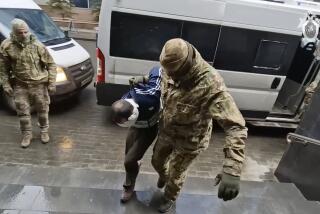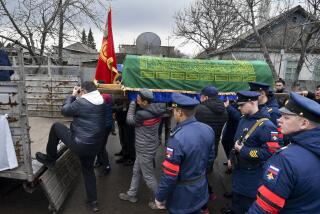Ethnic Battles in Soviet Asia Kill 11; 210 Injured : Housing: Kirghiz and Uzbeks clash a over plot of land near crowded city. The fighting comes as Gorbachev returns to face a rash of political problems.
- Share via
MOSCOW — In bloody proof of how critical the Soviet housing shortage can be, two rival ethnic groups in a Central Asian city battled violently for two days over a plot of land to build homes on, leaving at least 11 people dead and more than 200 injured.
The flare-up in the city of Osh, in Kirghizia, about 2,400 miles southeast of Moscow, occurred after thousands of Kirghiz and Uzbeks, both Turkic peoples and predominantly Muslim, faced off over a contested farm field.
The clashes, reportedly still raging as President Mikhail S. Gorbachev came home to Moscow from the United States on Tuesday evening, were dramatic reminders both of the Soviet Union’s volatile social problems and the explosiveness of minority relations in this country of more than 130 different ethnic groups.
Acknowledging the gravity of the housing problem, Gorbachev recently ordered the Council of Ministers to take extraordinary steps to meet the Kremlin’s commitment to grant each Soviet family its own apartment or home by the year 2000, a goal regarded by many as hopelessly optimistic.
Osh, a city of 209,000 in western Kirghizia near the border with Soviet Uzbekistan, became the latest flash point for the country’s social and ethnic grievances when Uzbeks, who make up most of the city’s population, were outraged at not having received more land for home construction, said Viktoria Shevchenko, correspondent of the Communist Party newspaper Sovietskaya Kirghiz.
“The problem is that many factories have been recently constructed in the city, and this has caused a great migration of people from rural areas,” said Shevchenko, speaking by telephone from Kirghizia’s capital, Frunze. “In other words, it has led to a housing crisis in the city. At present, over 12,000 people . . . (in Osh) are waiting their turn to get an apartment.”
The housing crisis is aggravated by Kirghizia’s birthrate, traditionally one of the highest in the Soviet Union, and the inability of officials in the mountainous republic of 4.2 million people on the Sino-Soviet border to create jobs for all new entrants into the labor pool.
Shevchenko said the confrontation had been simmering for a week in Osh, Kirghizia’s second-largest city and the site of Central Asia’s biggest textile mill. The dispute was sparked by the seizure by Kirghiz of land belonging to the Lenin Collective Farm on which the Kirghiz intended to build private houses.
Although those land seizures were illegal, Shevchenko said, Osh authorities gave in.
“Kirghiz were granted land lots for construction, which was resented by the Uzbek community,” the newspaper Komsomolskaya Pravda said. “Yesterday, the situation got out of control.”
On Monday, about 10,000 Uzbeks and 1,500 Kirghiz gathered on opposite sides of the farm field that had become the source of discord.
Kirghiz Prime Minister Apas Dzhumagulov, Communist Party secretary Medetkan Sherimkulov and city officials sped to the tract and addressed the crowds, trying to calm them, and police and Interior Ministry troops kept the quarreling groups apart.
But at 6 p.m., another large group of Kirghiz arrived at the field. Some media reports said that when 900 internal security troops and police fired blanks in an attempt to disperse the crowds, a rampage ensued. One report said that after the warning shots, crowds attacked police with stones and gasoline bombs.
“The raging crowd rushed to the center of the city, smashing automobile windshields and windows of stores and kiosks in its way,” said the official news agency Tass. “There were attempts to raid the building of the Interior Ministry and an investigation ward. These attempts were repulsed by Interior Ministry troops on duty.”
At least seven houses and eight automobiles were set ablaze and some stores were looted, Tass said.
In Moscow, the Interior Ministry said there were unconfirmed reports of bands of men on horseback riding though the city, terrorizing the population. Some of the rioters were believed to be armed with hunting rifles, the ministry said.
State-run Soviet television reported Tuesday night that 11 people had been killed and 210 injured in the unrest.
A state of emergency was proclaimed late Monday in Osh and environs and a 10 p.m.-to-6 a.m. curfew imposed, but fighting continued Tuesday, Interfax said.
Interior Ministry troops were reported to be guarding factories, manning roadblocks and patrolling the streets. The interior minister of Kirghizia, Maj. Gen. Viktor Goncahorv, was appointed military commander of the district, an unusual step that showed authorities were ready for more violence.
Housing is critically short in the five republics of Soviet Central Asia, all of which have a high birthrate, and its allocation has been the source of violent unrest before. In February, at least seven people were killed in the neighboring republic of Tadzhikistan and more than 100 injured in rioting triggered by rumors that resettled Armenian refugees would get priority for new housing.
Shevchenko blamed “red tape flourishing among functionaries” for the failure of Osh officials to provide housing within the city. People were provided with land to live outside the city while there were still plenty of vacant lots within city limits, she said.
Since so-called micro-neighborhoods outside city centers are often poorly provided with stores, schools and public transport, downtown is often the best place to live.
TURMOIL IN SOVIET CENTRAL ASIA
The Uzbeks and Kirghiz are both Turkic-speaking Muslim peoples. About two-thirds of the population of Uzbekistan, an ancient Persian province, is Uzbek, the rest being divided among Russia, Tatar, Kazakh and Tadzhik minorities. The Kirghiz, a people with Mongol strains, constitute about half the population of Kirghizia, the others being Russians, Uzbeks and Ukrainians. Both republics are productive agricultural areas and rich in minerals and petroleum deposits. Uzbekistan supplies the Soviet Union with 65% of its cotton, and the Kirghiz have traditionally excelled in wood carving, rug weaving and jewelry making.
More to Read
Sign up for Essential California
The most important California stories and recommendations in your inbox every morning.
You may occasionally receive promotional content from the Los Angeles Times.













